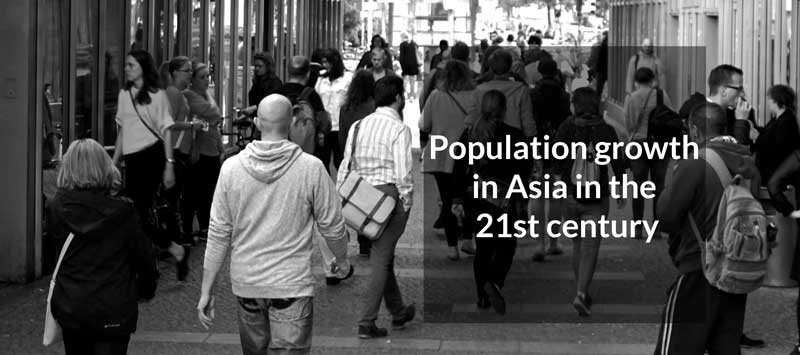Economic development everywhere exacts a price. Perhaps the greatest of these for most of Asia is the ironic one that as people live better they live longer and, hence, the total population continues to grow.
All Asian countries have long been crowded, not only in terms of people per square mile (Japan and Java top the world list, together with tiny Belgium and Holland) but also in relation to available resources.
China, for example, has only about half of the good-quality cultivated land plus pasture area of the United States, but must somehow feed more than four times as many people. India has still less, to support a population now about the same size as China’s.
No Asian country begins to be as well endowed with agricultural land, industrial minerals, or forest resources as the United States, with its far smaller population.
Asian forests have been cut into progressively for thousands of years by huge populations; wood is in very short supply, the soil is dangerously exposed to erosion, and unchecked runoff worsens floods and chokes rivers with silt.
As population pressure has mounted and economic growth has generated a greatly increased appetite for wood, cutting has increasingly removed the tree cover on slopes, with disastrous consequences.
So far this has been worst in China and India, the two biggest countries as well as those that have been longest inhabited by large populations. In both, most of the original forest cover has been destroyed, and attempts at reforestation are very far from keeping pace.
The disastrous floods in central China in 1954, and again in 1991 and 1998, were a direct consequence of continued deforestation. The construction of the Three Gorges Dam on the Yangzi in the early twenty-first century (for which 1.3 million people were relocated) has been matched with stepped-up forest restoration in the Yangzi basin, although forest cover is still dramatically less than it was in the 1950s.
In normally flood-prone Bangladesh and Assam, the scope and incidence of flooding, damage, and loss of life have increased, also due to deforestation. Southeast Asia contains one of the world’s major belts of tropical forest, which is thought to play a vital role in stabilizing world climate patterns.
Since about 1950 it too has been heavily cut into, to help feed economic growth domestically and to earn foreign exchange as exports to pay for new imports. The results, in the age of the chain saw and logging truck, are alarming. Only in Japan have strict regulations kept tree cutting to a minimum, but the difference is made up of heavy imports of wood, mainly from already endangered Southeast Asia.
Population increases continue to press more and more heavily on limited natural resources everywhere in Asia. Except for China and Indonesia, all Asian countries must import oil to feed their growing industrialization and fuel the rising number of vehicles that is an aspect of economic development.
Apart from the expense involved, oil is a vanishing resource that will disappear as the world uses it up in the course of the coming decades. Meanwhile, most of Asia, like most of the rest of the world, depends heavily on coal as its primary energy source.
Coal supplies, though finite, will outlast oil, and China, in particular, has large reserves, but the effects of the rising use of these fossil fuels on the environment are worrisome. The continuing increase in population makes all of these problems more oppressive and slows the real—that is, per capita—economic growth rate.
It is a little like a fat man trying to chin himself while continuing to gain weight. Efforts to limit population growth rates have ranged from draconian state policies in China to the provision of education and family planning in India to little or no official action.
Birth rates have come down nearly everywhere, but, excluding Japan, Taiwan, and Singapore, they are still well above death rates, and hence population continues to grow.
The cumulative experience of all countries, including those in the West, makes it clear that birth rates come down only as incomes rise and people feel reasonably secure.
Until that point is reached, infant mortality tends to be high (as it still is in most of the poor world), and this encourages couples to have multiple children in the hope that some will survive. Sons are especially important, particularly in Asia.
Except for Southeast Asia, daughters leave their parental families at marriage and join their husbands’ families, so they cannot be counted as economic assets and may cost the family heavily in dowry.
Sons and unmarried daughters contribute labor and provide the only economic security for parental old age, wherein in most of Asia the state still lacks adequate means to support the elderly or the sick. Sons can also continue the family name and line, which is still of basic importance to most Asians and can perform the death and commemorative rituals for parents that are still considered vital.
Families that produce only daughters continue to try for sons. As Mencius put it long ago, in fourth-century b.c.e. China, “Of all things that are unfilial, the greatest is to have no descendants.”
Under these circumstances, efforts to persuade people to have fewer children are blunted. Individual self-interest will remain best served by having many children, especially sons, as long as they remain the family’s chief security, sanctioned also by many centuries of cultural values.
In the rapidly growing cities, large families are more likely to be an economic liability, and for most urbanites income has also risen. Housing, food, jobs, education, and consumer goods must be found for urban children, who make less contribution to family welfare than on the farm, wherein in any case redundant individuals can more easily be absorbed into and supported by family structures.
Literacy is also higher in cities, and literacy levels everywhere correlate with lower birth rates, perhaps because literate people acquire other values and goals beyond simple reproduction. Urban birthrates have come down nearly everywhere, but outside Japan, Taiwan, South Korea, Hong Kong, and Singapore most Asians are still villagers.
In Japan, economic development brought security to just about everyone in the 1950s, and birth rates came down sharply so that the population since then has grown only minimally and is now below stability.
This was the pattern somewhat earlier in Europe and North America, for the same reasons, and it is now being replicated in Taiwan, South Korea, Hong Kong, and Singapore. But in most of the rest of the Asian countries populations continue to grow, while per capita income shares grow more slowly as a result.
The twentieth century saw considerable progress in the liberation of women, especially in China. Mao Zedong declared that “Women hold up half the sky,” and, although his behavior did not do much to support that idea, women were able to achieve substantial gains in education and employment.
Women among India’s middle classes also have many more opportunities in these areas. In Southeast Asia, women continued their traditional equality to or even dominance over men, while in Japan one still finds pretty much the opposite, although a little slow change has begun. But despite the advances in China and in India, women in general (again apart from Southeast Asia) have not yet achieved the degree of equality characteristic of the United States.
Much of this has to do with the Asian preference for sons and the fact of a patriarchal society, which also greatly retards the efforts to limit population growth, although in Japan the birth rate has come down to below replacement level, primarily as a result of new prosperity and economic security.




